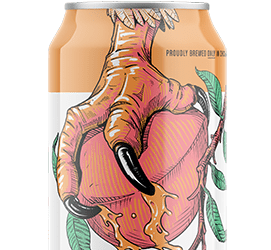Alem Bier’s Muscat Brett Saison clone
Alem Bier’s Muscat Brett Saison clone
(5 gallons/19 L, all-grain)
OG = 1.056 FG = 1.007
IBU = 13 SRM = 3 ABV = 6.8%
This saison with Brettanomyces from Alem Bier in Flores da Cunha, Brazil incorporates local Muscat grapes.
Ingredients
11.5 lbs. (5.2 kg) Pilsner malt
7 AAU Magnum hops (60 min.) (0.7 oz./20 g at 10% alpha acids)
1.25 gallons (5 L) Muscat grape must
French oak, medium toast
Bio4 Saison and LevTeck B1 (Brettanomyces blend), or Wyeast 3711 (French Saison) and White Labs WLP650 (Brettanomyces bruxellensis), or The Yeast Bay WLP4636 (Saison/Brettanomyces Blend II)
7⁄8 cup corn sugar (if priming)
Step by step
This recipe uses reverse osmosis (RO) water. Adjust all brewing water to a pH of 5.5 using phosphoric acid. Add 0.5 tsp. calcium chloride and 0.5 tsp. of calcium sulfate to the mash.
This recipe uses a step mash. In 18 quarts (17 L) water, mash in at 104 °F (40 °C) for 10 minutes. Raise to 126 °F (52 °C) for 10 minutes. Raise to 144 °F (62 °C) for 60 minutes. Raise to 153 °F (67 °C) for 10 minutes. Mash out at 169 °F (76 °C) for 15 minutes, recirculating.
Sparge slowly and collect 6.5 gallons (24.5 L) of wort.
Boil the wort for 60 minutes, adding hops at the beginning of the boil.
Chill the wort to 79 °F (26 °C), pitch the yeast, and ferment. When the beer is about 1.020 gravity, add the grape must, and ferment until complete.
At the brewery, this beer is aged in an old French oak barrel that had Ancellotta wine in it (an Italian grape variety with plantings in Brazil). Brettanomyces was pitched in the barrels. This can be simulated by using French oak cubes or spirals, pre-boiled for 15 minutes prior to use. Use 1 oz. (28 g) of oak for 9–12 months along with the Brett. Age the beer at cellar temperatures, 54–62 °F (12–17 °C), during this time.
Rack the beer, prime, and bottle condition, or keg and force carbonate to a high carbonation level.
Alem Bier’s Muscat Brett Saison clone
(5 gallons/19 L, extract only)
OG = 1.056 FG = 1.007
IBU = 26 SRM = 3 ABV = 6.8%
Ingredients
6.2 lbs. (2.8 kg) Pilsen dried malt extract
7 AAU Magnum hops (60 min.) (0.7 oz./20 g at 10% alpha acids)
1.25 gallons (5 L) Muscat grape must
French oak, medium toast
Bio4 Saison and LevTeck B1 (Brettanomyces blend), or Wyeast 3711 (French Saison) and White Labs WLP650 (Brettanomyces bruxellensis), or The Yeast Bay WLP4636 (Saison/Brettanomyces Blend II)
7⁄8 cup corn sugar (if priming)
Step by step
Use 6.5 gallons (24.5 L) of water in the brew kettle; heat to 158 °F (70 °C).
Turn off the heat. Add the malt extract and stir thoroughly to dissolve completely. You do not want to feel liquid extract at the bottom of the kettle when stirring with your spoon. Turn the heat back on and bring to a boil.
Boil the wort for 60 minutes, adding hops at the times indicated in the recipe.
Chill the wort to 79 °F (26 °C), pitch the yeast, and ferment. When the beer is about 1.020 gravity, add the grape must, and ferment until complete.
At the brewery, this beer is aged in an old French oak barrel that had Ancellotta wine in it (an Italian grape variety with plantings in Brazil). Brettanomyces was pitched in the barrels. This can be simulated by using French oak cubes or spirals, pre-boiled for 15 minutes prior to use. Use 1 oz. (28 g) of oak for 9–12 months along with the Brett. Age the beer at cellar temperatures, 54–62 °F (12–17 °C), during this time.
Rack the beer, prime, and bottle condition, or keg and force carbonate to a high carbonation level.
Tips for Success:
The yeasts used by Alem Bier are Brazilian, so some substitution is probably necessary (we’ve provided a couple of suggestions) but you could substitute with some other favorites of yours. Use a saison strain that is not overly clove-like. The Brett blend is mostly B. bruxellensis, but it is not very funky — it is floral and fruity. The Brett can take the beer down to 1.000 gravity.
The Moscato (Muscat) grape is very fresh, peachy, and floral in character. The target combination of the beer is to be floral and fruity with a bubbly texture, like a high-quality Asti sparkling wine.
The beer I judged was aged in the bottle for a further year and a half; two years would be a good target if you can wait that long.
Written by Gordon Strong




